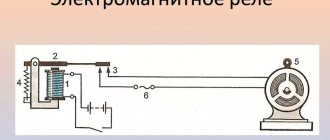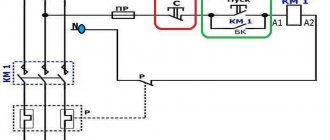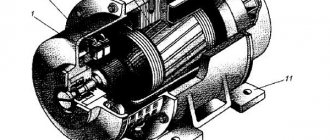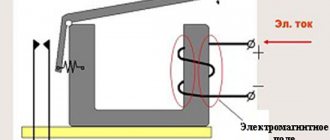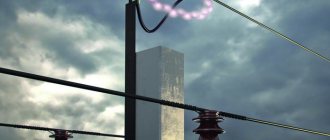Nowadays, we cannot do without a high-quality and well-thought-out power supply system. If, when purchasing an apartment, this problem is solved not by the owner of the property, but by a construction company, then there is a choice for supplying electricity to a private home. The apartment has already been supplied with single-phase power, and this voltage is quite sufficient there. However, in the private sector, a three-phase network may be quite relevant. In this article we will tell you which electrical network is better: three-phase or single-phase, as well as how to supply 380 Volts to a private house according to the law and what documents are needed for this.
The need for three-phase connection
In a single-phase network, often the only phase is overloaded due to the use of powerful units , which are becoming more and more common in modern homes. As a result, connected electrical appliances fail, creating an emergency situation that threatens a fire.
At the entrance to the house there are always three phases, which are distributed in a phase-zero set. Pairs power groups of loads of equal power. If a residential building is allocated 15 kW of power, then each group receives no more than 5 kW. If the rule is not followed, the circuit breakers will trip if the line is overloaded.
If consumers in the house require a total of more than 15 kW, a three-phase connection is needed
Equipment requiring a three-phase line connection:
- an electric heating boiler in a large house can take about 9 kW;
- water pump operating in a deep well;
- electric stove for baths, high-power saunas (from 5 kW);
- hob, oven;
- equipment for a private workshop at home, for example, milling and lathes, a circular saw, a welding machine, a jackhammer.
Such units can be found with a 220V connection, but 380V is more reliable, more powerful, and more economical . Modern devices for everyday use can be designed specifically for 380V, for example, a motor on a garage door or entrance to a yard.
Three phases are needed if there are three-phase motors on the site that are not designed to operate in single-phase regulation. Alternatively, the organization of such input is necessary when many electrical appliances are used at the same time, for example, a household has been developed, private production has been established.
They try to supply a three-phase power line to every private building, and the user can use it or not as he wishes.
Pros and cons of three-phase connection
Economical use of electricity
Low material consumption of transformers and power cables
Even load distribution
Synchronous and asynchronous current motors show high efficiency
It is possible to obtain simultaneously linear and phase voltage in one installation
Probability of reducing lamp flicker and stroboscopic effect of fluorescent lamps
In the event of an accident, one or two phases burn out, but for power supply there is the possibility of a temporary backup connection
Three phases are required if there is not enough single phase line, but in this case it is easier to request an increase in the limit
It is necessary to distribute the load evenly between phases
A new switchboard and accessories are required
The danger of electric shock increases, since the network contains not only single-phase voltage, but also linear
Advantages and disadvantages of a three-phase power supply system
To supply electricity to a private home, three-phase power is most often used, since it is superior to single-phase.
Such nutrition can allow:
- use of three-phase motors and other electrical receivers;
- when using a large number of electrical appliances, it is possible to distribute them into three phases, thus reducing the load on each phase;
- allows the use of input cables with a smaller cross-section;
- as a result of a break in one of the phases, the presence of light in the house will still be ensured;
- the risk of fires is significantly reduced.
And yet, along with these positive aspects, there are also a number of negative aspects:
- with a three-phase supply of electricity, the dimensions of the electrical panel will be increased several times. This is due to the size of the meter and the residual current device;
- a voltage of 380 volts can kill a person fatally , while 220V is the maximum permissible safe voltage;
- installation work related to wiring will be much more difficult;
- special attention should be paid to the wiring of the common zero, since if it breaks, an overvoltage will form in the phases, which will inevitably lead to the failure of all devices in this phase;
- the wiring diagram contains many more lines, thus increasing the required number of machines.
Requirements for connecting 380 volts
The rules for connecting the site are prescribed in the text of Federal Law No. 35 “On Electric Power Industry” dated March 26, 2003 (Articles 20 – 26), edited on December 27, 2019. The work of electric grid companies is regulated by Federal Law No. 135 “On the Protection of Competition” dated July 26, 2006.
Example specifications
Basic Rules:
- the user cannot independently connect electricity to the house; an energy supply organization is needed;
- connection is possible after fulfilling the requirements of the technical specifications;
- use cables with aluminum (not less than 16 mm²) or copper (not less than 10 mm²) conductors; armored cables are laid underground;
- with an aerial connection, the cable does not sag below the road below 6 m, above the sidewalks - below 3.5 m;
- the underground line is buried 0.7 - 1 m or lower;
- entry into the dwelling - not lower than 2.75 m from the ground;
- devices installed upstream of the electricity meter must be sealable.
In a 380V network, it is allowed to connect a three-phase meter in a private house with a maximum current strength of 50A, accuracy class - 2, last check - no more than 1 year ago. It is fixed on the DIN rail of the distribution panel, but it can be located outside the switchboard. The house must have a grounding system.
How to apply for a permit
The consumer has the right to connect to any electrical facility within 300 m from the site (power line supports, transformer substations, cable lines). The contract is concluded for a new connection, increasing power or moving the entry point.
List of project documents:
- site plan in the general layout of the development;
- connection diagram for power receivers;
- internal wiring diagram;
- PPR for connection.
The application is written at the company’s office, or submitted in your personal account through the website.
Information to be submitted with the application:
- Full name of the applicant;
- address of the connected site and the actual location of the user;
- project development period and commissioning time;
- power separation between phases;
- highest required power;
- type of load.
The company must meet deadlines for making decisions on the application. For individuals with a required power of up to 15 kW, this period is equal to 15 days, with other indicators or for a temporary connection - up to 30 days. After signing the contract, the specifications are given, which the user must exactly carry out on his site.
The owner notifies the company about the completion of preparation; in response, the electrical network checks the compliance of the specifications and the actual work in the presence of a representative of the supplier’s supply organization. A certificate of compliance is drawn up (within 3 days), the owner of the site signs the document within 5 days. This is followed by: an agreement on technological connection, an agreement on the supply of electricity. After this, 380V is supplied to the site.
Registration of permission
The company of electricity suppliers will need to submit a project for power supply to a private house for 15 kW in 3 phases. To do this, you will have to contact specialists who will accurately calculate the entire electrical power consumption on the site. And if it turns out to be insufficient for the needs of the living family, they will draw up a competent justification for the need to connect a three-phase power line to the house.
The project states:
- Network power consumption.
- Connection diagram.
- Equipment and materials used.
- Meter (multi-tariff or single-tariff).
- Grounding diagram.
The customer can indicate that he requires more than 15 kW of allocated network power. In this case, you need to provide a complete list of electrical equipment used on the site. It should include equipment that is located not only inside the residential building, but also devices located in the garage, workshop and throughout the territory.
Project for connecting to a three-phase network Source uk-parkovaya.ru
Selection of materials and equipment
Input components and the meter are placed on the distribution panel, the dimensions of which are determined by the number of connection points. Metal boxes with protection from moisture are placed outside, steel and plastic cabinets are used inside.
Set of components for connection:
- corrugated tubes, self-extinguishing or non-flammable cable ducts;
- copper cable VVGng;
- three-phase meter;
- connecting switches: combs, buses, terminals;
- protective and safety fittings;
- automatic circuit breakers complete with RCDs or combined automatic circuit breakers;
- a relay that protects against voltage surges in the circuit.
A DIN rail is prepared for high-quality fastening of automatic machines and protective devices; mounting spaces for these devices are provided on the bar.
To carry out internal wiring , you need wires, boxes for changing the direction of wiring, socket boxes and for switches. You will need alabaster or plaster to fix the cables in the wall grooves, clamps, electrical tape, and adapters.
An ungrounded socket has a phase on the left/right
Houses with old electrical wiring do not have common ground loops. Therefore, to save money, electrical outlets without grounding are used. When switching an electrical circuit, there is no need to select terminals for connecting the phase and neutral electrical wires.
Lack of grounding in the room is a source of danger when connecting faulty electrical consumers. A faulty power tool may cause voltage on the body. This is a dangerous factor, since contact with it closes the electrical circuit.
Input of three phases into the building and outgoing lines
All conductors are connected to the electrical panel, then the electric current enters the meter and passes to the distribution unit. Here the working zero and the grounding wire are separated, they are connected to the grounding bus, which is connected to the repeated grounding branch. Formation of outgoing lines :
- additional circuits come from the input switchboard (VRS);
- an introductory switch is installed in it, all phases are connected to it;
- circuit breakers are installed for each group circuit in the home, each of them is powered from different phases;
- groups are formed according to the power of units and devices so that each phase has approximately equal value;
- three phase conductors and a neutral conductor from the grounding bus are connected to the meter contacts;
- the meter output is connected to a common circuit breaker for the entire house.
Valera
The voice of the construction guru
Ask a Question
For connection, use the triangle or star method. The first method is to connect the phases sequentially: the end of the first to the beginning of the second, the end of the second to the beginning of the third, and so on. Star - when the ends of the phases are joined at a common point and the ends of the phases of consumer windings - also in one place.
Star and Delta circuits in a three-phase network
There are various variations for connecting a load with an operating voltage of 220 and 380 Volts to a three-phase network. These patterns are called “Star” and “Triangle”.
When the load is designed for a voltage of 220V, it is connected to a three-phase network according to the “Star” circuit , that is, to phase voltage. In this case, all load groups are distributed so that the powers in the phases are approximately equal. The zeros of all groups are connected together and connected to the neutral wire of the three-phase input.
All our apartments and houses with single-phase input are connected to Zvezda; another example is the connection of heating elements in powerful heaters and convection ovens.
When the load has a voltage of 380V, it is switched on according to the “Triangle” circuit, that is, to linear voltage. This phase distribution is most typical for electric motors and other loads where all three parts of the load belong to a single device.
Electrical panel assembly
The input switch and meter are sealed by power grid workers, so they are located at the beginning of the switchboard so as to provide this opportunity.
Step by step assembly:
- fastening of automatic devices and RCDs on the rail according to the drawn up diagram;
- connecting elements to the input switch using a comb;
- connecting phase wires with wires with lugs;
- installation and connection of the zero bus;
- checking (tightening) joints with a screwdriver;
- turning on the power, checking the operation of the machines;
- determining network parameters using a multimeter.
Before starting to operate the 380V network, make sure that all elements of the internal system (sockets, sockets, switches) are installed and connected.
What is line voltage?
In a three-phase main, additional voltage can be allocated by connecting a jumper between 2 loaded cables. Its value is higher because it is a projection onto the coordinate plane of 2 vectors making an angle of 120° to each other. The addition to the phase voltage value is 73% or calculated as √3-1. The generally accepted line voltage on a power line is always 380 volts.
Line voltage is the voltage between two phase wires (380 V).
The voltage is calculated in the phase gap or between their terminals. When installing a circuit, difficulties arise due to inaccuracy in calculating the conductor, which sometimes causes an accident. Connection diagrams differ in the options for combining loaded cores and a source of electricity. Advantages of a single-phase network:
- safe operation of the equipment, since the danger in terms of damage comes from 1 cable;
- the circuit is used to carry out effective wiring, select the operating principle, calculate parameters and perform measurements.
Calculations in the system are simple and are performed taking into account standard physical formulas. A multimeter is used to measure circuit indicators. The characteristics of the connection to the phase are determined using special voltmeters and current sensors.
Line voltage occurs when electric current passes through the submarine when the energy source and receiver are combined. When the power in the area between the generator output and the consumer decreases, the phase voltage parameters also change. Knowing the linear indicators, it is easy to calculate the value of the phase voltage.
Network Features:
- when wiring professional devices, a screwdriver with a built-in indicator is sufficient;
- when connecting wires, a zero is not used - due to the neutral core there is no danger of electric shock;
- the diagram is applicable for permanent networks and lines with alternating current;
- a single-phase connection is made in a three-phase line, but not vice versa.
Connecting sockets
The peculiarity of 380V sockets is that they block from asymmetrical connection to avoid short circuit. The contacts are placed at an angle, they are different in size, with guide elements.
Stationary 380V sockets are produced in the following types:
- 2P+PE has two power (phase) terminals and a grounding terminal;
- 3P+PE or 3P+N is characterized by three phase terminals and one for grounding connection;
- 3P+PE+N - there are places for connecting three phases, one for zero, one more for grounding.
The sockets are interlocked to prevent switching off under load. The current strength (25, 63, 125A) for which these sockets are made is significant, and the products do not have an arc-extinguishing effect. Removing plugs under such a load is dangerous in terms of burns or burnt out sockets. The lock can be of an electronic or mechanical type.
Sockets are connected to the power cable in series, parallel or in a mixed way.
Star and Delta circuits in a three-phase network
There are various variations for connecting a load with an operating voltage of 220 and 380 Volts to a three-phase network. These patterns are called “Star” and “Triangle”.
When the load is designed for a voltage of 220V, it is connected to a three-phase network according to the “Star” circuit , that is, to phase voltage. In this case, all load groups are distributed so that the powers in the phases are approximately equal. The zeros of all groups are connected together and connected to the neutral wire of the three-phase input.
All our apartments and houses with single-phase input are connected to Zvezda; another example is the connection of heating elements in powerful heaters and convection ovens.
When the load has a voltage of 380V, it is switched on according to the “Triangle” circuit, that is, to linear voltage. This phase distribution is most typical for electric motors and other loads where all three parts of the load belong to a single device.
Electrician's recommendations
For hidden wiring, built-in electrical panels are chosen, and exposed wires are connected in overhead distribution panels. The shield body is placed so that it can be easily reached.
Electricians advise observing the following conditions:
- horizontal sections of wires from the panel to the sockets are made at a height of 2.5 m from the floor;
- wiring in the walls is placed vertically or horizontally; it is prohibited to install it along an oblique line;
- connect the wires with adapters in installation boxes;
- the underground connection to the power pole is made with a single piece of wire without connections;
- Do not connect the switch to the neutral wire;
- When laying on wooden walls, insulating hoses with asbestos linings are used.
The distribution housing is selected according to the type of room, taking into account the characteristics of the microclimate - in aggressive environments, boxes with maximum protection from direct water jets and dust are used.
How can two phases appear in a regular 220-volt outlet?
From school physics lessons, everyone has learned a little knowledge about electricity and knows how many phases there are in an outlet. In serviceable ones there is always one phase and zero. When carrying out repair work or operating the electrical supply system, the lighting of an apartment or a separate room sometimes disappears. What to do? If, after turning on the gas station, the apartment’s electrical appliances do not work. Measuring the presence of voltage indicates that the socket shows two phases; what reason could lead to this malfunction - this needs to be clarified.
Experience shows that a common cause of this phenomenon is a break in the neutral wire. The presence of a phase instead of zero is explained by the fact that the voltage, passing through any switched-on network element, returns to the zero contact of the electrical outlet.
In order to verify the correctness of this statement, it is enough to turn off all electrical equipment in the apartment.
The following may cause a malfunction:
- faulty fuses;
- break of the neutral electrical wire of the input distribution board;
- break of ground junction box of the room;
- breakdown of electrical plugs when using old wiring.
Straw house
You can often hear electrical networks called three-phase, two-phase, or less often single-phase, but sometimes these concepts do not mean the same thing. In order not to get confused, let's figure out how these networks differ and what they mean when they talk, for example, about the differences between three-phase and single-phase current
.
| Single-phase networks | Two-phase networks | Three-phase networks |
| The passage of current is possible in a closed circuit. Therefore, the current must first be supplied to the load and then returned back. With alternating current, the wire supplying the current is a phase. Its circuit designation is L1 (A). The second one is called zero. Designation - N. This means that to transmit single-phase current you need to use two wires. They are called phase and zero, respectively. Between these wires the voltage is 220 V. | There is a transmission of two alternating currents. The voltage of these currents is phase shifted by 90 degrees. They transmit currents through two wires: two phase and two neutral. It is expensive. Therefore, now it is not generated at power plants and is not transmitted via power lines. | Three alternating currents are transmitted. In phase, their voltages shift by 120 degrees. It would seem that six wires had to be used to transmit current, but using a “star” connection of sources, three are used (the type of circuit is similar to the Latin letter Y). Three wires are phase, one is neutral. Economical. Current is easily transmitted over long distances. Any pair of phase wires has a voltage of 380 V. Pair of phase wire and neutral - voltage 220 V. |
Thus, the power supply to our houses and apartments can be single-phase or three-phase.
Single phase power supply
Single-phase current is connected in two ways
: 2-wire and 3-wire.
- The first (two-wire) uses two wires. One carries phase current, the other is intended for the neutral wire. In a similar way, power supply is supplied to almost all old houses built in the former USSR.
- In the second case, another wire is added. It is called grounding (PE). Its purpose is to save human life and devices from breakdown.
Three-phase power supply
Distributing three-phase power throughout the house is done in two ways
: 4-wire and 5-wire.
- A four-wire connection is made with three phase and one neutral wire. After the electrical panel, two wires are used to power sockets and switches - one of the phases and zero. The voltage between these wires is 220V.
- Five-wire connection - a protective grounding wire (PE) is added.
In a three-phase network, the phases should be loaded as evenly as possible. Otherwise, phase imbalance will occur. The result of this phenomenon is very disastrous and unpredictable for human life and technology.
What kind of electrical wiring in the house depends on what electrical equipment can be included in it.
For example, grounding, and therefore sockets with a grounding contact, are required when the following are connected to the network:
- high-power appliances - refrigerators, ovens, heaters,
- electronic household appliances - computers, televisions (it is necessary to remove static electricity),
- water-related devices - Jacuzzis, showers (water is a current conductor).
And to power the motors (relevant for a private home), three-phase current is needed.
How much does it cost to connect single-phase and three-phase electricity?
Costs for consumables and equipment installation are also planned based on the most preferred connection. And if it’s difficult to predict the cost of sockets, switches, and lamps (it all depends on the whims of your imagination and the designer’s), then the prices for installation work are approximately the same
. On average this is:
- assembly of an electrical panel in which circuit breakers (12 groups) and a meter are installed costs from $80
- installation of switches and sockets $2-6
- installation of spotlights $1.5-5 per unit.
***
Personally, I also thought about solar panels - I did a little research on https://220volt.com.ua, now I’m trying to structure my thoughts on how and what to do with their connection...

